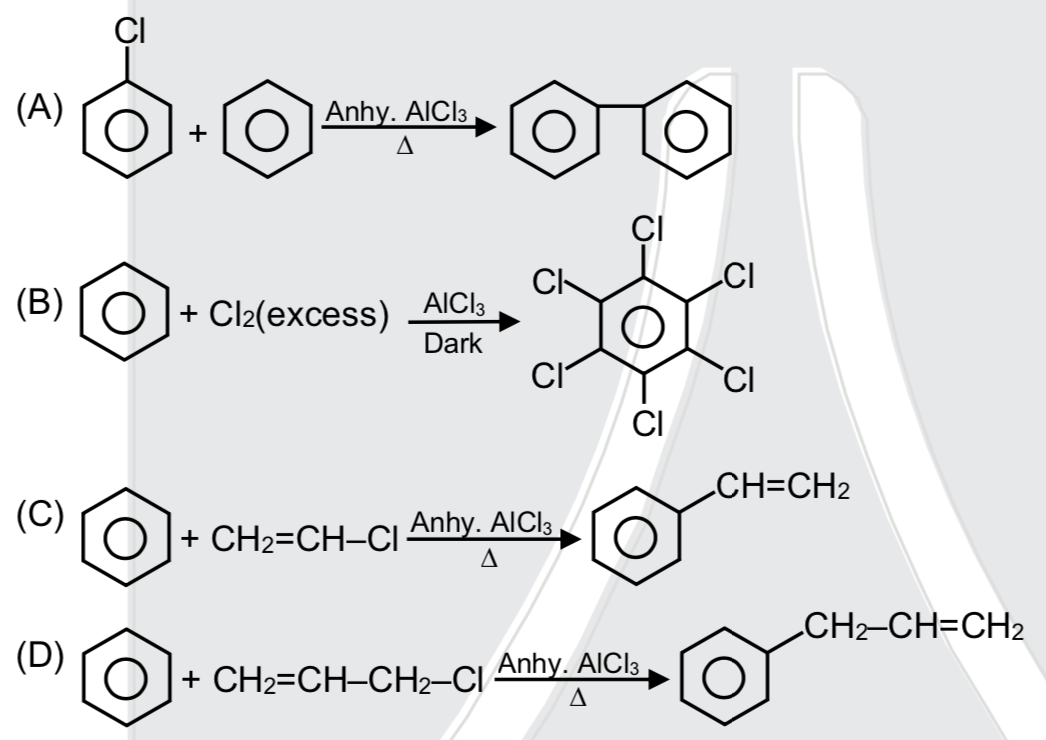Which one of the following is a possible nuclear reaction ?
.510B+.42He→.137N+.11H
.2311Na+.11H→.2010Ne+.42He
.23993Np→.23994Pu+.−1β0+¯v
.117N+.11H→.126C+.−1β0+¯v
The correct Answer is:C
To determine which of the given nuclear reactions is possible, we need to check if the equations are balanced in terms of both mass number (A) and atomic number (Z). A balanced nuclear reaction will satisfy the conservation of mass and charge.
1. Understand the Components of a Nuclear Reaction:
- A nuclear reaction can be represented as:
Reactants→Products
- Each component has a mass number (A) and atomic number (Z).
2. Check the Given Reactions:
- We need to analyze each of the four reactions provided to see if they are balanced.
3. Analyze Each Reaction:
- Reaction 1:
10+2→7+1+13
- Left Side: Mass number = 10 + 2 = 12; Atomic number = 0 (not given).
- Right Side: Mass number = 7 + 1 + 13 = 21; Atomic number = 0 (not given).
- Conclusion: Not balanced.
- Reaction 2:
11+1→10+2
- Left Side: Mass number = 11 + 1 = 12; Atomic number = 0 (not given).
- Right Side: Mass number = 10 + 2 = 12; Atomic number = 0 (not given).
- Conclusion: Balanced.
- Reaction 3:
8+8→5+11+1
- Left Side: Mass number = 8 + 8 = 16; Atomic number = 0 (not given).
- Right Side: Mass number = 5 + 11 + 1 = 17; Atomic number = 0 (not given).
- Conclusion: Not balanced.
- Reaction 4:
12+4→8+8
- Left Side: Mass number = 12 + 4 = 16; Atomic number = 0 (not given).
- Right Side: Mass number = 8 + 8 = 16; Atomic number = 0 (not given).
- Conclusion: Balanced.
4. Final Evaluation:
- Among the four reactions, only Reaction 2 is balanced in terms of both mass number and atomic number. Therefore, it is the only possible nuclear reaction.
Conclusion:
The possible nuclear reaction is Reaction 2.
- A nuclear reaction can be represented as:
Reactants→Products
- Each component has a mass number (A) and atomic number (Z).
- We need to analyze each of the four reactions provided to see if they are balanced.
- Reaction 1:
10+2→7+1+13
- Left Side: Mass number = 10 + 2 = 12; Atomic number = 0 (not given).
- Right Side: Mass number = 7 + 1 + 13 = 21; Atomic number = 0 (not given).
- Conclusion: Not balanced.
11+1→10+2
- Left Side: Mass number = 11 + 1 = 12; Atomic number = 0 (not given).
- Right Side: Mass number = 10 + 2 = 12; Atomic number = 0 (not given).
- Conclusion: Balanced.
8+8→5+11+1
- Left Side: Mass number = 8 + 8 = 16; Atomic number = 0 (not given).
- Right Side: Mass number = 5 + 11 + 1 = 17; Atomic number = 0 (not given).
- Conclusion: Not balanced.
12+4→8+8
- Left Side: Mass number = 12 + 4 = 16; Atomic number = 0 (not given).
- Right Side: Mass number = 8 + 8 = 16; Atomic number = 0 (not given).
- Conclusion: Balanced.
- Among the four reactions, only Reaction 2 is balanced in terms of both mass number and atomic number. Therefore, it is the only possible nuclear reaction.
The possible nuclear reaction is Reaction 2.
Topper's Solved these Questions
- BOOK - NCERT FINGERTPS ENGLISHCHAPTER - PRACTICE PAPPEREXERCISE - Practice Paper 150videos
PRACTICE PAPPER
- BOOK - NCERT FINGERTPS ENGLISHCHAPTER - PRACTICE PAPPEREXERCISE - Practice Paper 250videos
PRACTICE PAPPER
- BOOK - NCERT FINGERTPS ENGLISHCHAPTER - PRACTICE PAPPEREXERCISE - Practice Papper 250videos
PRACTICE PAPPER
- BOOK - NCERT FINGERTPS ENGLISHCHAPTER - NUCLEIEXERCISE - Assertion And Reason15videos
NUCLEI
- BOOK - NCERT FINGERTPS ENGLISHCHAPTER - RAY OPTICS AND OPTICAL INSTRUMENTSEXERCISE - NCERT Exemplar11videos
RAY OPTICS AND OPTICAL INSTRUMENTS
Similar Questions
Knowledge Check
- Question 1 - Select One
Which of the following reaction is possible ?
AC6H5OH+HBr→C6H5Br+H2OB(CH3)3CCl+NaOCH3→(CH3)3COCH3+NaClC D
D
- Question 2 - Select One
Which of the following reaction is possible ?
AC6H5OH+HBr→C6H5Br+H2OB(CH3)3CCl+NaOCH3→(CH3)3COCH3+NaClC D
D
- Question 3 - Select One
Which of the following reaction is possible ?
AC6H5OH+HBr→C6H5Br+H2OB(CH3)3CCl+NaOCH3→(CH3)3COCH3+NaClC D
D
Which of the following reactions are possible ?
 View Solution
View SolutionWhich of the following reactions are possible ?
 View Solution
View SolutionWhich of the following reaction is possible ?
View SolutionWhich one of the following carries extra nuclear genetic material ?
View SolutionWhich one of the following is not possible in a cyclic process?
View Solution

